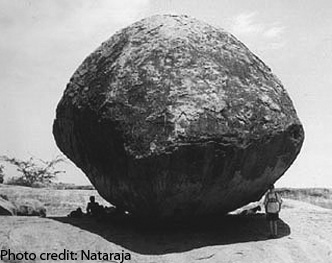Item WE022004: Very large rocks the size of boulders can come from breaking off from earth's solid rock layer and from breaking off from larger rocks.
The picture below shows a very large rock with people underneath it.

What is TRUE about where such very large rocks come from?
- Large rocks break off from even larger rocks, and large rocks break off from the earth's solid rock layer.
- Large rocks break off from even larger rocks, but large rocks do not break off from the earth's solid rock layer.
- Large rocks form when smaller rocks stick together, large rocks do not come from breaking off from earth's solid rock layer or from larger rocks.
- Large rocks do not come from smaller rocks sticking together, and they do not come from breaking off from even larger rocks or from the earth's solid rock layer. Large rocks have always been the same as they are today.
- Distribution of Responses

- Students Responding Correctly
| Group | Correct | Total | Percent |
|---|---|---|---|
| Overall | 1424 | 2496 | 57% |
| Grades | |||
| 6–8 | 826 | 1502 | 55% |
| 9–12 | 595 | 984 | 60% |
| Gender | |||
| Male | 702 | 1206 | 58% |
| Female | 700 | 1247 | 56% |
| Primary Language | |||
| English | 1286 | 2206 | 58% |
| Other | 106 | 223 | 48% |
- NRC Framework
- ESS2.B Most distributions of rocks within Earth’s crust, including minerals, fossil fuels, and energy resources, are a direct result of the history of plate motions and collisions...
- MS ESS2.B Plate movements are responsible for most continental and ocean floor features and for the distribution of most rocks and minerals within Earth’s crust.

